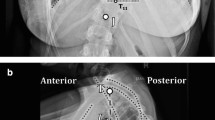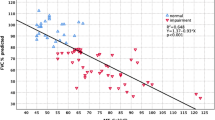Abstract
Objective
Our study aimed to evaluate the pulmonary function of patients with severe scoliosis after correcting standing height with spino-pelvic index (SPI).
Methods
Inclusion criteria: (1) with a coronal Cobb angle of more than 90°; (2) diagnosed as congenital (CS) or idiopathic scoliosis (IS); (3) aged between ten and 20 years; (4) with pulmonary function test (PFT) at the primary consultation. Patients with previous surgical intervention, with angular kyphosis, and with neuromuscular disease were excluded. Length of spine (LOS), height of spine (HOS), and height of pelvis (HOP) were measured on coronal films. SPI was defined as the ratio between LOS and HOP. The corrected body height was calculated: corrected body height = body height + (SPI × HOP − HOS). The PFTs included the following parameters: VCmax, FVC, FVC% predicted, FEV1, FEV1% predicted, PEF, and MVV. PFT results were recalculated using the corrected body height.
Results
Thirty patients were diagnosed as IS and 27 as CS with average Cobb angles of 99.88° ± 11.83 and 98.06° ± 14.27, respectively. Significant differences were observed in VCmax and FVC between IS and CS patients (P < 0.05). All the corrected PFT parameters were significantly lower than the original PFT parameters (P < 0.05).
Conclusion
For the first time, this study proposed a method to predict pulmonary function of patients with severe scoliosis using SPI, as an age-independent parameter in normal adolescents. After body height correction, pulmonary function of patients with severe scoliosis was found to be significantly decreased, indicating that pulmonary function impairment was underestimated in patients with severe scoliosis when evaluating pulmonary function with arm span.

Similar content being viewed by others
References
Day G, Upadhyay S, Ho E, Leong J, Ip M (1994) Pulmonary functions in congenital scoliosis. Spine 19(9):1027–1031
Kim YJ, Lenke LG, Bridwell KH, Kim KL, Steger-May K (2005) Pulmonary function in adolescent idiopathic scoliosis relative to the surgical procedure. J Bone & Joint Surg 87(7):1534–1541
Payo J, Perez-Grueso FS, Fernandez-Baillo N, Garcia A (2009) Severe restrictive lung disease and vertebral surgery in a pediatric population. Euro Spine J : Off Pub Euro Spine Soc Euro Spinal Deformity Soc Euro Section Cervical Spine Res Soc 18(12):1905–1910. https://doi.org/10.1007/s00586-009-1084-8
Sponseller PD, Cohen MS, Nachemson AL, Hall JE, Wohl ME (1987) Results of surgical treatment of adults with idiopathic scoliosis. J Bone Joint Surg Am 69(5):667–675
Cooper DM, Rojas JV, Mellins RB, Keim HA, Mansell AL (1984) Respiratory mechanics in adolescents with idiopathic scoliosis. Am Rev Respir Dis 130(1):16–22
Tsiligiannis T, Grivas T (2012) Pulmonary function in children with idiopathic scoliosis. Scoliosis 7(1):7. https://doi.org/10.1186/1748-7161-7-7
Koller H, Zenner J, Gajic V, Meier O, Ferraris L, Hitzl W (2012) The impact of halo-gravity traction on curve rigidity and pulmonary function in the treatment of severe and rigid scoliosis and kyphoscoliosis: a clinical study and narrative review of the literature. Euro Spine J : Off Pub Euro Spine Soc Euro Spinal Deformity Soc Euro Section of the Cervical Spine Res Soc 21(3):514–529. https://doi.org/10.1007/s00586-011-2046-5
Dreimann M, Hoffmann M, Kossow K, Hitzl W, Meier O, Koller H (2014) Scoliosis and chest cage deformity measures predicting impairments in pulmonary function: a cross-sectional study of 492 patients with scoliosis to improve the early identification of patients at risk. Spine (Phila Pa 1976) 39(24):2024–2033. https://doi.org/10.1097/brs.0000000000000601
Bumpass DB, Lenke LG, Bridwell KH, Stallbaumer JJ, Kim YJ, Wallendorf MJ, Min WK, Sides BA (2014) Pulmonary function improvement after vertebral column resection for severe spinal deformity. Spine (Phila Pa 1976) 39(7):587–595. https://doi.org/10.1097/brs.0000000000000192
Sancho-Chust JN, Chiner E, Camarasa A, Senent C (2010) Differences in pulmonary function based on height prediction obtained by using alternative measures. Respir Int Rev Thor Dis 79(6):461–468. https://doi.org/10.1159/000235862
Golshan M, Crapo RO, Amra B, Jensen RL, Golshan R (2007) Arm span as an independent predictor of pulmonary function parameters: validation and reference values. Respirology (Carlton, Vic) 12(3):361–366. https://doi.org/10.1111/j.1440-1843.2007.01070.x
Hibbert ME, Lanigan A, Raven J, Phelan PD (1988) Relation of armspan to height and the prediction of lung function. Thorax 43(8):657–659
Tyrakowski M, Kotwicki T, Czubak J, Siemionow K (2014) Calculation of corrected body height in idiopathic scoliosis: comparison of four methods. Euro Spine J : Off Publ Euro Spine Soc Euro Spinal Deform Soc Euro Section of the Cervical Spine Res Soc 23(6):1244–1250. https://doi.org/10.1007/s00586-014-3275-1
Capderou A, Berkani M, Becquemin MH, Zelter M (2011) Reconsidering the arm span-height relationship in patients referred for spirometry. Eur Respir J 37(1):157–163. https://doi.org/10.1183/09031936.00199209
Bao H, Liu Z, Yan P, Qiu Y, Zhu F (2015) Disproportionate growth between the spine and pelvis in patients with thoracic adolescent scoliosis. Bone Joint J 97(12):1668–1674
Tay KS, Bassi A, Yeo W, Yue WM (2017) Associated lumbar scoliosis does not affect outcomes in patients undergoing focal minimally invasive surgery-transforaminal lumbar interbody fusion (MISTLIF) for neurogenic symptoms-a minimum 2-year follow-up study. Spine J : Off J North Am Spine Soc 17(1):34–43. https://doi.org/10.1016/j.spinee.2016.05.022
Chong HS, Padua MR, Kim JS, Lee HM, Moon SH, Suk KS, Hak Sun K (2015) Usefulness of noninvasive positive-pressure ventilation during surgery of flaccid neuromuscular scoliosis. J Spinal Disord Tech. https://doi.org/10.1097/bsd.0000000000000234
Nepple JJ, Lenke LG (2009) Severe idiopathic scoliosis with respiratory insufficiency treated with preoperative traction and staged anteroposterior spinal fusion with a 2-level apical vertebrectomy. Spine J : Off J North Am Spine Soc 9(7):e9–e13. https://doi.org/10.1016/j.spinee.2009.01.009
Harrison RA, Siminoski K, Vethanayagam D, Majumdar SR (2007) Osteoporosis-related kyphosis and impairments in pulmonary function: a systematic review. J Bone and Miner Res : Off J Am Soc Bone and Miner Res 22(3):447–457. https://doi.org/10.1359/jbmr.061202
Emans JB, Ciarlo M, Callahan M, Zurakowski D (2005) Prediction of thoracic dimensions and spine length based on individual pelvic dimensions in children and adolescents: an age-independent, individualized standard for evaluation of outcome in early onset spinal deformity. Spine (Phila Pa 1976) 30(24):2824–2829
Gold M, Dombek M, Miller PE, Emans JB, Glotzbecker MP (2014) Prediction of thoracic dimensions and spine length on the basis of individual pelvic dimensions: validation of the use of pelvic inlet width obtained by radiographs compared with computed tomography. Spine (Phila Pa 1976) 39(1):74–80. https://doi.org/10.1097/brs.0000000000000036
Glotzbecker M, Johnston C, Miller P, Smith J, Perez-Grueso FS, Woon R, Flynn J, Gold M, Garg S, Redding G, Cahill P, Emans J (2014) Is there a relationship between thoracic dimensions and pulmonary function in early-onset scoliosis? Spine (Phila Pa 1976) 39(19):1590–1595. https://doi.org/10.1097/brs.0000000000000449
Kjensli A, Ryg M, Falch JA, Armbrecht G, Diep LM, Eriksen EF, Ellingsen I (2010) Does body height reduction influence interpretation of lung function in COPD patients? Eur Respir J 36(3):540–548. https://doi.org/10.1183/09031936.00148609
Krege JH, Kendler D, Krohn K, Genant H, Alam J, Berclaz PY, Coffey B, Loghin C (2015) Relationship between vertebral fracture burden, height loss, and pulmonary function in postmenopausal women with osteoporosis. J Clin Densitometry : Off J Int Soci Cli Densitometry. https://doi.org/10.1016/j.jocd.2015.02.004
Lao L, Weng X, Qiu G, Shen J (2013) The role of preoperative pulmonary function tests in the surgical treatment of extremely severe scoliosis. J Orthop Surg Res 8:32. https://doi.org/10.1186/1749-799x-8-32
Koumbourlis AC (2014) Chest wall abnormalities and their clinical significance in childhood. Paediatr Respir Rev 15(3):246–254; quiz 254–245. https://doi.org/10.1016/j.prrv.2013.12.003
Leong JC, Lu WW, Luk KD, Karlberg EM (1999) Kinematics of the chest cage and spine during breathing in healthy individuals and in patients with adolescent idiopathic scoliosis. Spine (Phila Pa 1976) 24(13):1310–1315
Funding
This study was funded by the Nanjing Clinical Medical Center, Jiangsu Provincial Key Medical Center, and supported by the health bureau of Jiangsu (Q201510).
Author information
Authors and Affiliations
Corresponding author
Ethics declarations
All methods were performed in accordance with the relevant guidelines and regulations. Informed consent has been obtained from each participant in this study.
Conflict of interest
The authors declare that they have no conflict of interest.
Ethical approval
This article does not contain any studies with human participants or animals performed by any of the authors.
Informed consent
Informed consent was obtained from all individual participants included in the study.
Rights and permissions
About this article
Cite this article
Zhao, Zh., Bao, Hd., Tseng, Cc. et al. Prediction of respiratory function in patients with severe scoliosis on the basis of the novel individualized spino-pelvic index. International Orthopaedics (SICOT) 42, 2383–2388 (2018). https://doi.org/10.1007/s00264-018-3877-z
Received:
Accepted:
Published:
Issue Date:
DOI: https://doi.org/10.1007/s00264-018-3877-z




